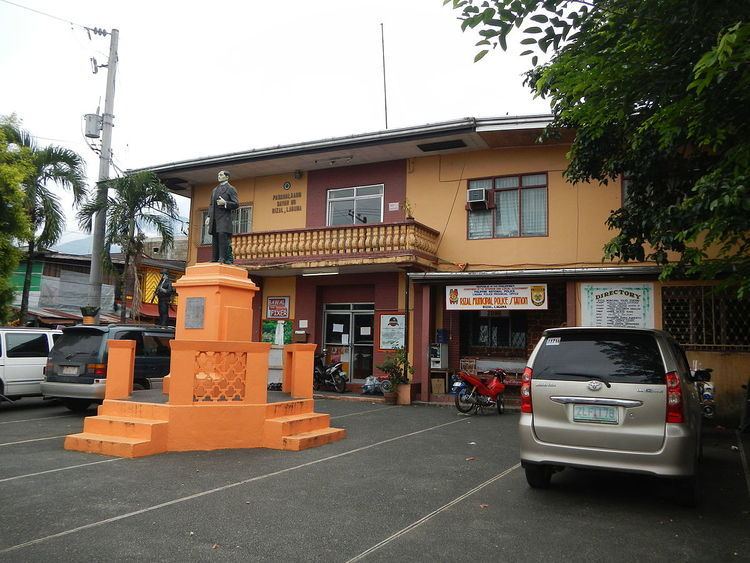Founded January 7, 1919 Time zone PST (UTC+8) Population 15,518 (2010) | Barangays Area 27.9 km² Local time Monday 11:33 AM Dialling code 49 | |
 | ||
Weather 29°C, Wind NE at 13 km/h, 51% Humidity Neighborhoods Tala, Entablado, East Poblacion, West Poblacion, Pook, Tuy, Paule 1, Paule 2, Antipolo, Talaga | ||
Rizal is a fifth class municipality in the province of Laguna, Philippines. It is a landlocked municipality located 25 kilometres (16 mi) from the provincial capital Santa Cruz and is bounded on the north by municipality of Calauan, on the east by Nagcarlan, on the west by San Pablo City, and on the south by Dolores, Quezon. According to the 2010 census, it has a population of 15,518 people. This municipality was named after José Rizal, the country's national hero.
Contents
Map of Rizal, Laguna, Philippines
From San Pablo is an uphill zigzag road going to Rizal. Rizal is one of the youngest towns in Laguna although it has long been sitting there amidst coconut trees, basking by the foothills of Mount San Cristobal, Mount Banahaw, and the Basilin Hill.
Trivia: This town is the birthplace of the milky mixed vegetable dish called "amenudong gulay". The people from this town have an old tradition of celebrating Christmas on January 6. There was also a legend St. Michael the Archangel apparitions in the town's biggest natural spring "Bukal ni San Miguel" during the Spanish era, making St. Michael the town's patron saint. Rizal, Laguna is also the hometown of Filipina actress-politician Angelica Jones.
Barangays
Rizal is politically subdivided into 12 barangays.
History
The kaingineros were among the first reported settlers in this part of Laguna around the 17th century. Around mid-1800, this village was called barrio "Pauli" and became part to the town of Nagcarlan.
Residents from this village used to say that the barrio "Pauli" got its name from the way the its brook flows at the edge of the settlement, whose stream flows back and forth. “Pauli,” must have come from the Tagalog word “Pauli-uli,” which means back and forth.
Ever since, local villagers earn their living by farming. The soil in this barrio is rich and water is abundant for there were numerous natural springs around the settlement, making the settlers enjoy bountiful harvests of coconuts, root crops, vegetables, and rice. Locales also thrive by fishing from the Mayton and Mayit brooks and Lake Kalibato, which the village share with the town of Sampalok, which is now San Pablo City.
It was only during the American regime did Pauli become a town, independent from Nagcarlan. The American Federal Government named Pedro Urrea the Municipal President. Nevertheless, Pauli’s township lasted only for a brief two years. Its inability to support its administrative expenses caused Pauli to affiliate once more with its former mother town.
However, between 1912 and 1915, residents led by Fortunato Urrea Arban, Agustin Vista, and Felix Isles, former municipal councilors campaigned to regain their municipal status. The petition included the inclusion of barrios Antipolo, Entablado, Laguan, Pook, Mayton, Pauli, Talaga and Tuy. On December 18, 1918, Governor Charles M. Yeater issued Executive Order 56 creating the Municipality of Rizal, naming the town after the foremost national hero Dr. Jose P. Rizal.
Officials inaugurated the new town a year after on January 7, 1919 naming Fortunato Urrea Arban town mayor. Before the citizens of Pauli won back their township, Innocente Sumague donated a piece of land for the construction of a church in 1916. Construction workers quarried Mayton Creek for stones and gravel. The quarry claimed many lives before the construction ended, in time for the midnight mass of Christmas of 1917.
Pablo Urrea became the mayor in 1941 and subsequently relinquished his post to lead the guerrilla fighters during the Japanese occupation. Beginning the Second World War, Japanese Imperial forces occupied and entered the municipal town of Rizal in 1942. Local guerrilla resistance fighters began the encounter conflicts and battling sieges at the municipal town of Rizal from 1942 to 1944 are aiding the ongoing Filipino troops and officers of the Philippine Commonwealth Army was gazing attack by the Japanese and almost three year encounters, the local guerrillas retreating Japanese troops during the occupation. Filipino troops of the Philippine Commonwealth Army and Philippine Constabulary was liberated the municipal town of Rizal in 1945 was aided the local guerrilla resistance force to defeats and attacking Imperial Japanese forces and ended in World War II.
